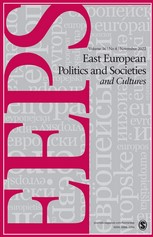Introduction: Civic Activism in Central and Eastern Europe Thirty Years After Communism’s Demise
Introduction: Civic Activism in Central and Eastern Europe Thirty Years After Communism’s Demise
Author(s): Dorota Pietrzyk-Reeves, Patrice C. McMahonSubject(s): Civil Society, Political history, Politics and society, Post-War period (1950 - 1989), Transformation Period (1990 - 2010), Present Times (2010 - today), History of Communism
Published by: SAGE Publications Ltd
Keywords: civil society; Central and Eastern Europe; civic activism; everyday activism; post-communism;
Summary/Abstract: Thirty years ago, many credited civil society for communism’s sudden and mostly peaceful demise in Central and Eastern Europe (CEE). In the decades since, scholars have debated the definition, structure, impact, and strength of civil societies in this region. This article introduces a special section that provides theoretical, methodological, and empirical considerations of civil society activism in CEE thirty years after the end of communist regimes in the region. Based on our new multi-country survey instrument and extensive field research, we contend that despite important differences in civil society and democracy’s trajectories within the region, there are commonalities emerging, with new forms of civic activism which are more informal, more dynamic, and ad hoc, often focused on “everyday issues” that average people identify as important and worthy of engagement. Unlike much previous research that focused on formal organizations and institutional conditions, we argue that civil society development in CEE needs to be analyzed from the perspective of actors—activists and citizens—and the concrete concerns that motivate the varied forms of their civic activism.
Journal: East European Politics and Societies
- Issue Year: 36/2022
- Issue No: 04
- Page Range: 1315-1334
- Page Count: 20
- Language: English
- Content File-PDF

